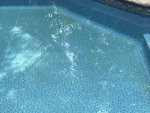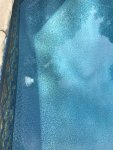I've posted in the past about our recurring metal staining issues. I'm at the end of my rope dealing with this frustrating issue. Before this season started, we had to repair a section of vinyl liner track that had come undone from the pool wall. I took the chance to do an AA treatment and drained all but the deep end of the pool. Even with all that water removal, my water stain problems this season are just as bad as they've ever been, maybe even worse.
I'm starting to think that my issue may be related to the salt chlorinating cell. I'm wondering if the chlorine level and pH levels inside the cell are enough to break down my metal sequestrant and/or make my metals drop out of solution. I have a floor cleaning system and it seems like the staining in concentrated on the areas where the wall jets and floor jets spray. My liner is completely stain free above the wall jets (they only spray down the wall).
I sent water samples to the makers of the CuLator product. They do professional water testing. You basically send them a sample of your pool water as well as a sample of your source (fill) water to make sure the source water is not the problem. Much to my dismay, their testing found no metals in my water. They sent me an email today after I emailed them a video showing that happens when I add GLB Metal Magnet to the pool stain. It's immediately removed.
This season, I'm only able to keep the stains at bay for about a week before I have to use a stain remover (GLB Metal Magnet - which smells like citric acid, not sure of the actual ingredients) or ascorbic acid. I prefer GLB Metal Magnet as it doesn't seem to have the high chlorine demand that ascorbic acid seems to have. This season, it's almost like my metal sequestrant is not working at all. I'm using Jack's Purple stuff. I have gone thru 4 bottles in the past month and the stains just keep coming back.
Here is a video I shot this weekend showing how effective GLB Metal Magnet is at removing the pool staining. I sent this video to the chemist that just did my water testing. They sent me an email asking to call but I missed them before they left for the day so I'll be calling them tomorrow.
Citric acid effect on pool stain - YouTube
A couple seasons, ago, I tried Jack's Stain ID kit and it indicated my stains are iron. I've basically run out of things to check. Nothing in my pool is corroding. I've checked the skimmer screws, the pool light, I even replaced my pool ladder with a polymer ladder to rule out corrosion from the ladder or hardware. I also re-hired my pool contractor to re-plump by pool equipment with additional Jandy never-lube valves that allow me to completely bypass my swimming pool heater to rule out any corrosion from the heater copper exchanger.
I'm thinking about turning off the salt chlorinator and just manually dosing the pool with liquid chlorine to see if the staining is reduced. Do you guys have any other suggestions or ideas?
I'm starting to think that my issue may be related to the salt chlorinating cell. I'm wondering if the chlorine level and pH levels inside the cell are enough to break down my metal sequestrant and/or make my metals drop out of solution. I have a floor cleaning system and it seems like the staining in concentrated on the areas where the wall jets and floor jets spray. My liner is completely stain free above the wall jets (they only spray down the wall).
I sent water samples to the makers of the CuLator product. They do professional water testing. You basically send them a sample of your pool water as well as a sample of your source (fill) water to make sure the source water is not the problem. Much to my dismay, their testing found no metals in my water. They sent me an email today after I emailed them a video showing that happens when I add GLB Metal Magnet to the pool stain. It's immediately removed.
This season, I'm only able to keep the stains at bay for about a week before I have to use a stain remover (GLB Metal Magnet - which smells like citric acid, not sure of the actual ingredients) or ascorbic acid. I prefer GLB Metal Magnet as it doesn't seem to have the high chlorine demand that ascorbic acid seems to have. This season, it's almost like my metal sequestrant is not working at all. I'm using Jack's Purple stuff. I have gone thru 4 bottles in the past month and the stains just keep coming back.
Here is a video I shot this weekend showing how effective GLB Metal Magnet is at removing the pool staining. I sent this video to the chemist that just did my water testing. They sent me an email asking to call but I missed them before they left for the day so I'll be calling them tomorrow.
Citric acid effect on pool stain - YouTube
A couple seasons, ago, I tried Jack's Stain ID kit and it indicated my stains are iron. I've basically run out of things to check. Nothing in my pool is corroding. I've checked the skimmer screws, the pool light, I even replaced my pool ladder with a polymer ladder to rule out corrosion from the ladder or hardware. I also re-hired my pool contractor to re-plump by pool equipment with additional Jandy never-lube valves that allow me to completely bypass my swimming pool heater to rule out any corrosion from the heater copper exchanger.
I'm thinking about turning off the salt chlorinator and just manually dosing the pool with liquid chlorine to see if the staining is reduced. Do you guys have any other suggestions or ideas?





